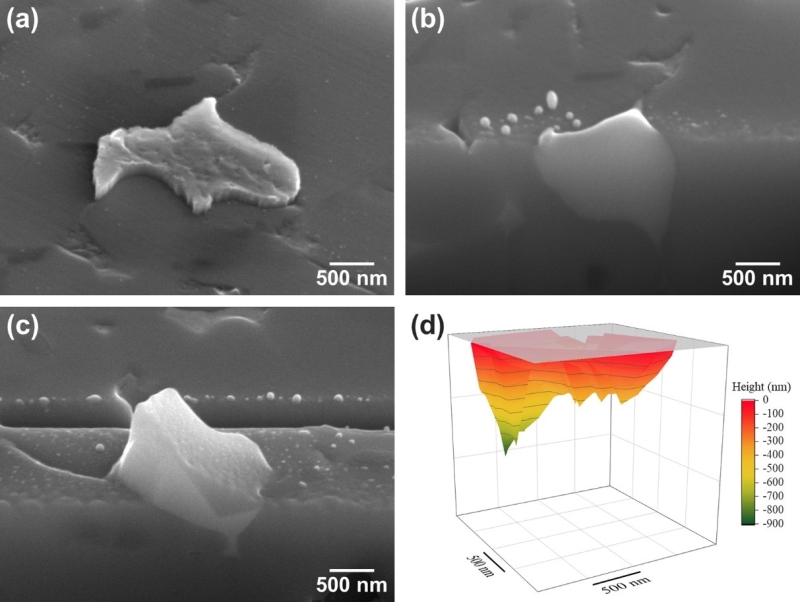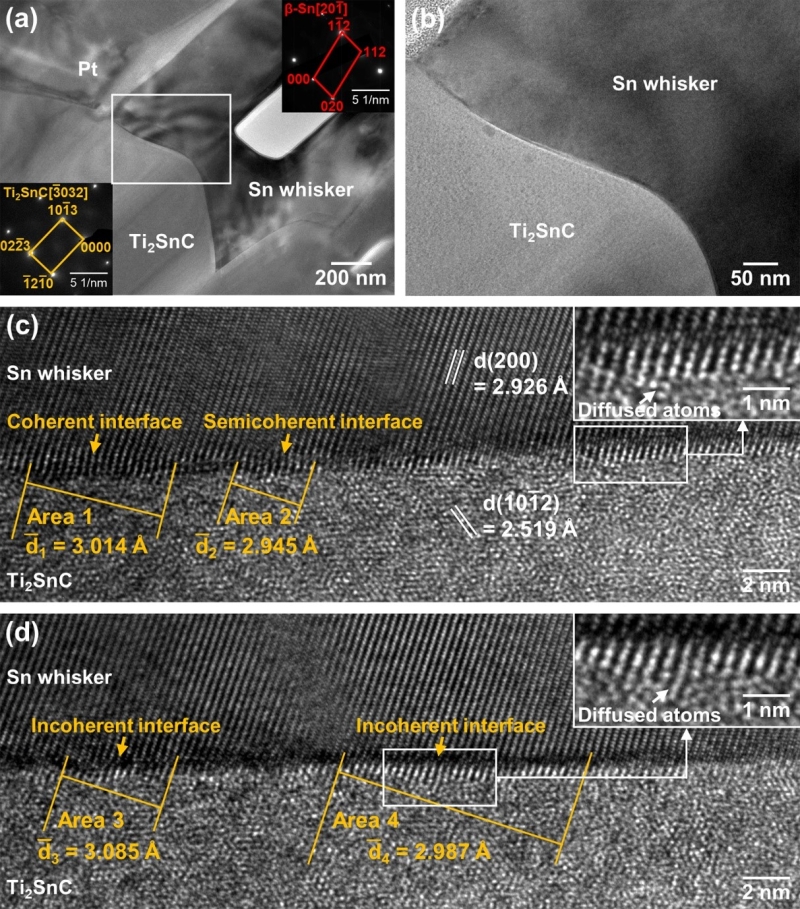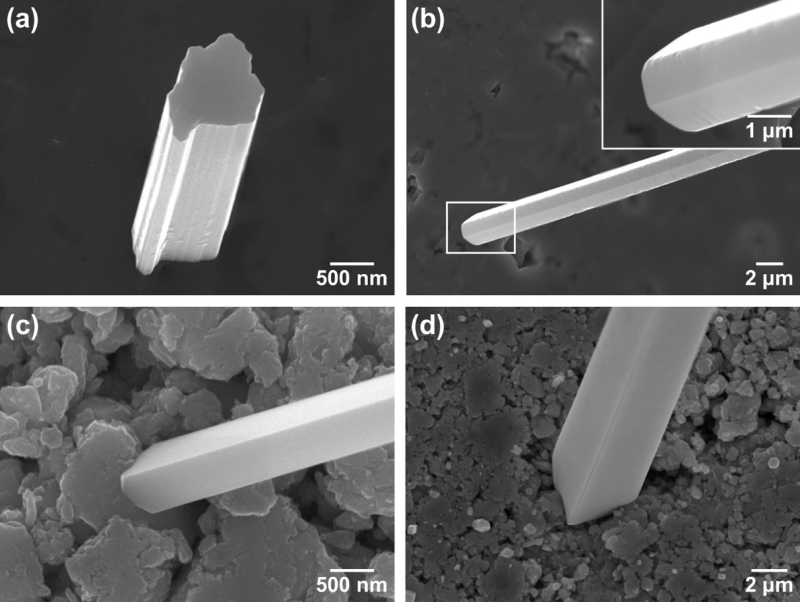锡晶须自发生长是一个困扰人们70余年的电路系统可靠性问题。在过去的几十年中,研究者提出了诸多理论以解释晶须自发生长现象,但这些理论多集中于晶须生长的驱动力研究,对晶须生长过程中的原子运动一直缺乏明确认识。近日,东南大学孙正明教授团队结合实验和理论计算,从原子运动角度对Ti2SnC中Sn晶须自发生长机理进行了研究。该研究成果以“Mechanisms behind the spontaneous growth of Tin whiskers on the Ti2SnC ceramics”为题,发表于金属领域的顶级期刊Acta Materialia 185(2020) 433。博士研究生刘玉爽和博士后陆成杰博士为论文共同第一作者,张培根副教授和孙正明教授为共同通讯作者。
The spontaneous growth of Tin whiskers has been a reliability issue in electronic assemblies for around 70 years. In the past several decades, many whisker growth theories have been proposed to interpret the whiskering phenomenon. However, most of the theories focused on the driving force. Investigations regarding the atomic motion in whisker growth process are seldom reported. Recently, by first-principles calculations and experimental characterizations, Sun’s group in Southeast University studied the mechanisms behind the spontaneous Sn whisker growth on Ti2SnC from the point of atomic motion. The article entitled “Mechanisms behind the spontaneous growth of Tin whiskers on the Ti2SnC ceramics” has been published in Acta Materialia 185(2020) 433. Yushuang Liu and Dr. Chengjie Lu are the first authors, Dr. Peigen Zhang and Prof. ZhengMing Sun are the corresponding authors.
在该项研究工作中,研究人员首先通过Ti2SnC基体成分调控,明确了自由Sn是Ti2SnC中Sn晶须自发生长的必要条件。随后对晶须根部微观结构的FIB-SEM表征发现Sn晶须根部与Ti2SnC基体中的自由Sn并不连通(图1),表明供应晶须生长的Sn原子很可能是通过Ti2SnC中的Sn原子层进行扩散的。采用FIB-TEM对Sn晶须/Ti2SnC界面的微观结构进行了进一步表征,在界面上发现了Sn原子从Ti2SnC中扩散出来并与晶须根部结合的痕迹(图2),明确了晶须生长所需的Sn原子通过Ti2SnC中的Sn原子层进行扩散。Ti2SnC中空位形成能和迁移能的第一性原理模拟结果进一步证实了这种扩散行为在能量上的可行性。同时,结合β-Sn表面能的第一性原理计算和不同生长环境中晶须形貌分析,该研究还发现Sn原子扩散出基体后,晶须会呈现出由低表面能晶面包围的棱柱状形貌以降低体系总能量;但当晶须处于氧化性气氛时,由于晶须表面氧化膜的存在限制了原子的横向扩散,晶须会保持继承自晶须根部的条纹状形貌(图3)。这一工作从原子尺度明确了Sn晶须生长过程中的原子扩散机理和Sn晶须的形貌形成机理,也为理解其他材料中的金属晶须自发生长问题提供了理论基础。
In this work, free Sn source was found to be necessary for the formation of Sn whiskers according to the substrate composition control. Afterwards, the microstructure at the base of Sn whisker was characterized by FIB-SEM. It was found that the whisker root is not in contact with free Sn in the substrate (Fig. 1), which suggests that the Sn atoms feeding Sn whisker growth probably diffuse through the Ti2SnC lattice. The interface microstructure between Sn whisker and the Ti2SnC substrate was further characterized by FIB-TEM. Sn atoms diffused from the Ti2SnC substrate and bonded to whisker root were observed (Fig. 2), which suggests that Sn atoms feeding Sn whisker growth are diffusing through the Ti2SnC lattice. This diffusion behavior is further supported according to the simulation results on the formation and migration energies of vacancies in Ti2SnC. Meanwhile, the whisker morphology formation mechanism has been studied by the combination of surface energy calculation of β-Sn and whisker morphology analysis. When Sn atoms diffuse out of the substrate, Sn whiskers bounded by low-energy planes form to minimize the total energy, while the whiskers maintain the striated morphology inherited from the whisker root in the environment containing oxygen, which is mainly attributed to the confinement of the oxide film on whisker surface (Fig. 3). The findings in the present work reveal the atom diffusion and the morphology formation mechanisms behind Sn whisker growth on Ti2SnC, which will also assist the understanding of the general whiskering problems in other materials.
该项研究得到了国家自然科学基金(51731004和51902051)、东南大学至善青年学者支持计划、东南大学国际博士后交流项目和中央高校基本科研业务费专项资金(2242019R20008)的资助。
This work was supported by the Grants of National Natural Science Foundation of China (51731004 and 51902051), the Zhishan Youth Scholar Program of Southeast University, the International Postdoctoral Exchange Program of Southeast University, and the Fundamental Research Funds for the Central Universities (2242019R20008).
文章链接:https://doi.org/10.1016/j.actamat.2019.12.027

图1晶须根部微观结构:(a)生长于Ti2SnC基体的Sn晶须;(b)图(a)中晶须的截面形貌;(c)进行三维重构的Sn晶须的一个截面;(d)图(c)中晶须根部形貌的三维重构结果。
Fig. 1 Microstructure at the base of a Sn whisker: (a) Sn whisker grown on Ti2SnC; (b) cross-sectional morphology of the whisker in (a); (c) one cross-section of the Sn whisker to be reconstructed; (d) reconstruction result of the whisker root in (c).

图2 Ti2SnC/Sn晶须界面微观结构:(a)界面TEM形貌和相应的选区电子衍射花样;(b)图(a)中白色矩形区域的放大图;(c)和(d)界面HRTEM形貌。
Fig. 2 Interface microstructure between Ti2SnC and Sn whisker: (a) TEM image of the interface, and the insets show the corresponding SAED patterns; (b) magnified view of the white rectangle area in (a); (c) and (d) HRTEM images of the interface.

图3氧化和非氧化性气氛中形成的Sn晶须:(a)空气气氛中形成的条纹状晶须;(b)氩气气氛中形成的六棱柱状晶须;(c)和(d)氩气气氛中形成的四棱柱状晶须。
Fig. 3 Sn whiskers formed in oxidizing and non-oxidizing atmospheres: (a) stiated Sn whisker formed in air; (b) hexagonal Sn whisker formed in argon; (c) and (d) quadrangular Sn whiskers formed in argon.